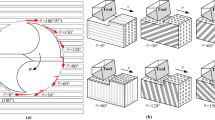Abstract
The process of a single-tooth cutting formation is taken as the representative to analyze the fracture mechanism of the formation with natural flaws under the PDC drill bit. The modeling of the stress field distribution of the formation under a single tooth is proposed first. Subsequently, the modeling of the stress intensity factor K, T-stress and the initiation angle \(\theta \) of the flaw under two far-field compressive loads in two cases are presented based on the mode-II fracture. Finally, the results of theoretical calculations and simulations are given and discussed. Based on the analysis undertaken, it can be concluded that the confinement ratio \(\lambda \) applying on the flaw changes nonlinearly with the variation in \(\alpha +\varphi \). The relationship between the dimensionless ratio \(\beta _{{x}}/\beta _{{y}}\) of T-stress and the rotational polar angle \(\varphi \) is a parabola with an upward opening. When the direction of the cutting force is consistent with the flaw, the stress intensity factor K and the initiation angle \(\theta \) at the tip of the flaw reach the maximum. In addition, the angle between the cutting force and the flaw weakens the T-stress and inhibits the crack initiation and propagation of the flaw. The results of numerical simulations show good agreement with theoretical calculations.











Similar content being viewed by others
Abbreviations
- F :
-
Cutting force (N)
- \(\alpha \) :
-
Force angle of cutting tooth (\(^{\circ }\))
- \(\varphi \) :
-
Angle between the force and the flaw, namely rotational polar angle (\(^{\circ }\))
- \(\chi \) :
-
Stress function
- x, y :
-
Horizontal and vertical distances between the cutting force and the flaw (m)
- a :
-
Half-length of the flaw (m)
- \(\theta \) :
-
Initiation angle of the flaw (\(^{\circ }\))
- \(\beta \) :
-
Inclination angle of the flaw (\(^{\circ }\))
- \(\sigma _{{x}}\), \(\sigma _{{y}}\) :
-
Far-field normal stresses applying on the flaw along the x- and y-directions (MPa)
- \(K_{\mathrm {II}}\) :
-
Mode-II stress intensity factor at the tip of the flaw (\(\hbox {MPa}\,\hbox {mm}^{\mathrm {0.5}}\))
- \(T_{{x}}\), \(T_{{y}}\) :
-
T-stresses along the x- and y-directions (MPa)
- \(\mu \) :
-
Coulomb friction coefficient
- \(\lambda \) :
-
Confinement ratio
- \(r_{\mathrm {c}}\) :
-
Critical distance of crack initiation (m)
References
Hoek E, Martin CD. Fracture initiation and propagation in intact rock: a review. J Rock Mech Geotech Eng. 2014;6(4):287–300.
Wong LNY, Einstein HH. Crack coalescence in molded gypsum and Carrara marble: part 1. Macroscopic observations and interpretation. Rock Mech Rock Eng. 2009;42(2):475–511.
Silva B, Gonçalves D, Einstein H. Modeling of crack initiation, propagation and coalescence in rocks. Int J Fract. 2013;182(2):167–86.
Li H, Wong LNY. Influence of flaw inclination angle and loading condition on crack initiation and propagation. Int J Solids Struct. 2012;49(18):2482–99.
Zhu XH, Tang LP, Tong H. Effects of high-frequency torsional impacts on rock drilling. Rock Mech Rock Eng. 2014;47(4):1345–54.
Ma LF, Yari N, Wiercigroch M. Shear stress triggering brittle shear fracturing of rock-like materials. Int J Mech Sci. 2018;146–147:295–302.
Li YW, Long M, Zuo LH, et al. Brittleness evaluation of coal based on statistical damage and energy evolution theory. J Pet Sci Eng. 2019;172:753–63.
Jin XQ, Wang GY, Keer LM, et al. Modeling crack growth from pores under compressive loading with application to metallic glasses. J Alloys Compd. 2011;509S:S115–8.
Gratchev I, Dong HK, Chong KY. Strength of rock-like specimens with preexisting cracks of different length and width. Rock Mech Rock Eng. 2016;49(9):4491–6.
Zhou YN, Lin JS. On the critical failure mode transition depth for rock cutting. Int J Rock Mech Min Sci. 2013;62:131–7.
Liu WJ, Zhu XH, Jing J. The analysis of ductile-brittle failure mode transition in rock cutting. J Pet Sci Eng. 2018;163:311–9.
Zhou XP, Bi J, Qian QH. Numerical simulation of crack growth and coalescence in rock-like materials containing multiple pre-existing flaws. Rock Mech Rock Eng. 2015;48:1097–114.
Wong LNY, Zhang XP. Size effects on cracking behavior of flaw-containing specimens under compressive loading. Rock Mech Rock Eng. 2014;47:1921–30.
Eftekhari M, Baghbanan A, Hashemolhosseini H. Crack propagation in rock specimen under compressive loading using extended finite element method. Arab J Geosci. 2016;9:145.
Shi F. Study on the cracking process of rock using the extended finite element method. Doctoral Thesis. China University of Mining and Technology; 2015.
Cao P, Liu TY, Pu CZ, et al. Crack propagation and coalescence of brittle rock-like specimens with pre-existing cracks in compression. Eng Geol. 2015;187:113–21.
Zhou XP, Cheng H, Feng YF. An experimental study of crack coalescence behaviour in rock-like materials containing multiple flaws under uniaxial compression. Rock Mech Rock Eng. 2014;47:1961–86.
Park CH, Bobet A. Crack initiation, propagation and coalescence from frictional flaws in uniaxial compression. Eng Fract Mech. 2010;77:2727–48.
Willemse EJM, Pollard DD. On the orientation and patterns of wing cracks and solution surfaces at the tips of a sliding flaw or fault. J Geophys Res. 1998;103:B2427–38.
Mutlu O, Pollard DD. On the patterns of wing cracks along an outcrop scale flaw: a numerical modeling approach using complementarity. J Geophys Res. 2008;113:B06403.
Landau LD, Pitaevskii LP, Kosevich AM, et al. Theory of Elasticity. Theoretical Physics, vol. 7. 3rd ed. Amsterdam: Elsevier; 2012.
Li XF, Lee KY, Tang GJ. Kink angle and fracture load for an angled crack subjected to far-field compressive loading. Eng Fract Mech. 2012;82:172–84.
Acknowledgements
The support of National Natural Science Foundation of China (No. 51704074) and Youth Science Foundation of Heilongjiang Province (No. QC2018049) is gratefully acknowledged. The work is also supported by Talent Cultivation Foundation (Nos. SCXHB201703; ts26180119; td26180141) and Youth Science Foundation (No. 2019QNL-07) of Northeast Petroleum University.
Author information
Authors and Affiliations
Corresponding author
Rights and permissions
About this article
Cite this article
Li, S., Li, W., Yan, T. et al. Fracture Mechanism of the Formation with a Natural Flaw Under a Single-Tooth Cutting. Acta Mech. Solida Sin. 33, 719–730 (2020). https://doi.org/10.1007/s10338-020-00167-y
Received:
Revised:
Accepted:
Published:
Issue Date:
DOI: https://doi.org/10.1007/s10338-020-00167-y




